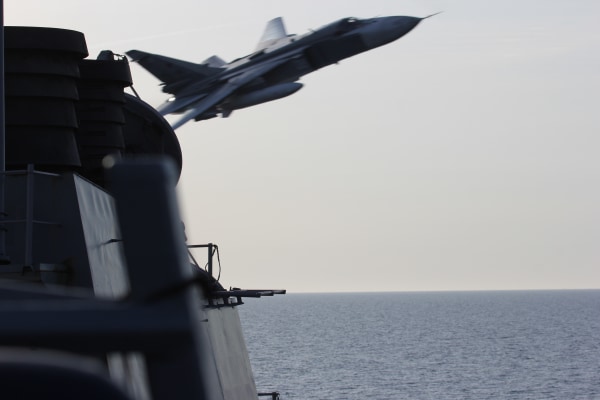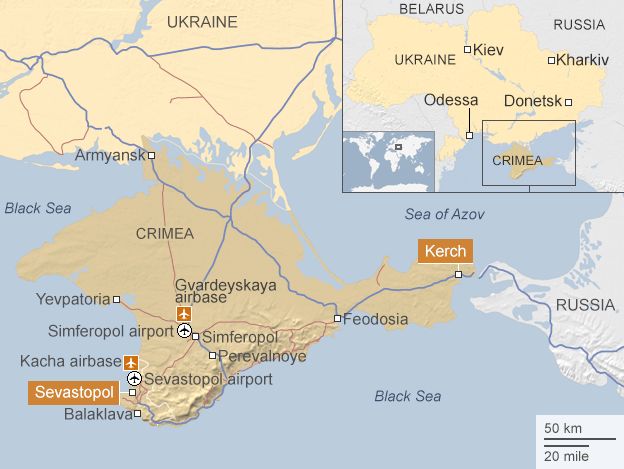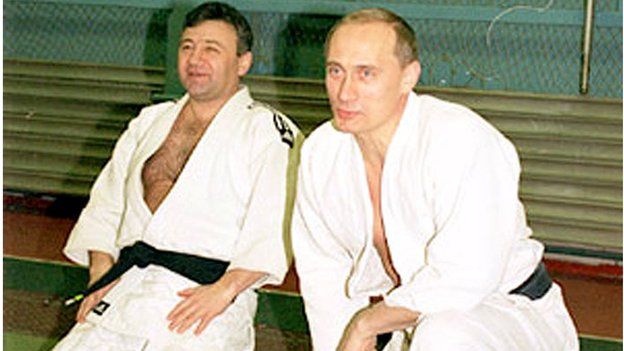Earlier this week, the Russians buzzed a U.S. guided missile destroyer in the Baltic Sea. This occurred 11 times over 2 days. It is an educated guess that this provocation was meant to be a classified occurrence but our military is angry and leaked it into the public domain. This is hardly the first time the Russians have behave outside the scope of international pacts and conditions against the West and allies.
The Russians did have a response to our complaints, that is if there were any from Washington:
NBC: A U.S. official said the maneuvers were “unsafe” and “unprofessional” — and that the jets were so low they left “wake in the water.” He said a Russian KA-27 helicopter also made seven passes above the destroyer and was believed to be photographing the ship.
Russian Ministry of Defense spokesman Maj. Gen. Igor Konashenkov hit back Thursday, saying that “upon visual contact, the Russian pilots have executed a turnaway from the ship, compliant to all safety regulations.”
Safety regulations? Whose regulations exactly? There is something called the IncSea that prevents as one of the issues THE exact type of incident that Russia is guilty of. Additionally, the Cold War Museum has an interesting story about this exact matter.
Agreement Between the Government of The United States of America and the Government of The Union of Soviet Socialist Republics on the Prevention of Incidents On and Over the High Seas
Bureau of International Security and Nonproliferation
Signed at Moscow May 25, 1972
Entered into force May 25, 1972Narrative
Treaty Text
ProtocolIn the late 1960s, there were several incidents between forces of the U.S. Navy and the Soviet Navy. These included planes of the two nations passing near one another, ships bumping one another, and both ships and aircraft making threatening movements against those of the other side. In March 1968 the United States proposed talks on preventing such incidents from becoming more serious. The Soviet Union accepted the invitation in November 1970, and the talks were conducted in two rounds — October 1, 1971, in Moscow and May 17, 1972, in Washington, D.C. The Agreement was signed by Secretary of the Navy John Warner and Soviet Admiral Sergei Gorshkov during the Moscow summit meeting in 1972. Specifically, the agreement provides for:
- steps to avoid collision;
- not interfering in the “formations” of the other party;
- avoiding maneuvers in areas of heavy sea traffic;
- requiring surveillance ships to maintain a safe distance from the object of investigation so as to avoid “embarrassing or endangering the ships under surveillance”;
- using accepted international signals when ships maneuver near one another;
- not simulating attacks at, launching objects toward, or illuminating the bridges of the other partys ships;
- informing vessels when submarines are exercising near them; and
- requiring aircraft commanders to use the greatest caution and prudence in approaching aircraft and ships of the other party and not permitting simulated attacks against aircraft or ships, performing aerobatics over ships, or dropping hazardous objects near them.
The agreement also provides for: (1) notice three to five days in advance, as a rule, of any projected actions that might “represent a danger to navigation or to aircraft in flight”; (2) information on incidents to be channeled through naval attaches assigned to the respective capitals; and (3) annual meetings to review the implementation of the Agreement.
The protocol to this agreement grew out of the first meeting of the Consultative Committee established by the agreement. Each side recognized that its effectiveness could be enhanced by additional understandings relating to nonmilitary vessels. In the protocol signed in Washington, D.C., on May 22, 1973, each party pledged not to make simulated attacks against the nonmilitary ships of the other.
Like other confidence-building measures, the Incidents at Sea Agreement does not directly affect the size, weaponry, or force structure of the parties. Rather, it serves to enhance mutual knowledge and understanding of military activities; to reduce the possibility of conflict by accident, miscalculation, or the failure of communication; and to increase stability in times of both calm and crisis. In 1983, Secretary of the Navy John Lehman cited the accord as “a good example of functional navy-to-navy process” and credited this area of Soviet-American relations with “getting better rather than worse.” In 1985, he observed that the frequency of incidents was “way down from what it was in the 1960s and early 1970s.”
Agreement Between the Government of The United States of America and the Government of The Union of Soviet Socialist Republics on the Prevention of Incidents On and Over the High Seas
Signed at Moscow May 25, 1972
Entered into force May 25, 1972The Government of the United States of America and the Government of the Union of Soviet Socialist Republics,
Desiring to assure the safety of navigation of the ships of their respective armed forces on the high seas and flight of their military aircraft over the high seas, and
Guided by the principles and rules of international law,
Have decided to conclude this Agreement and have agreed as follows:
Article I For the purpose of this Agreement, the following definitions shall apply:1. “Ship” means:
(b) Naval auxiliaries of the Parties, which include all naval ships authorized to fly the naval auxiliary flag where such a flag has been established by either Party.
(a) A warship belonging to the naval forces of the Parties bearing the external marks distinguishing warships of its nationality, under the command of an officer duly commissioned by the government and whose name appears in the Navy list, and manned by a crew who are under regular naval discipline;
2. “Aircraft” means all military manned heavier-than-air and lighter-than-air craft, excluding space craft.
3. “Formation” means an ordered arrangement of two or more ships proceeding together and normally maneuvered together.
Article II The Parties shall take measures to instruct the commanding officers of their respective ships to observe strictly the letter and spirit of the International Regulations for Preventing Collisions at Sea, hereinafter referred to as the Rules of the Road. The Parties recognize that their freedom to conduct operations on the high seas is based on the principles established under recognized international law and codified in the 1958 Geneva Convention on the High Seas.
Article III 1. In all cases ships operating in proximity to each other, except when required to maintain course and speed under the Rules of the Road, shall remain well clear to avoid risk of collision.2. Ships meeting or operating in the vicinity of a formation of the other Party shall, while conforming to the Rules of the Road, avoid maneuvering in a manner which would hinder the evolutions of the formation.
3. Formations shall not conduct maneuvers through areas of heavy traffic where internationally recognized traffic separation schemes are in effect.
4. Ships engaged in surveillance of other ships shall stay at a distance which avoids the risk of collision and also shall avoid executing maneuvers embarrassing or endangering the ships under surveillance. Except when required to maintain course and speed under the Rules of the Road, a surveillant shall take positive early action so as, in the exercise of good seamanship, not to embarrass or endanger ships under surveillance.
5. When ships of both Parties maneuver in sight of one another, such signals (flag, sound, and light) as are prescribed by the Rules of the Road, the International Code of Signals, or other mutually agreed signals, shall be adhered to for signalling operations and intentions.
6. Ships of the Parties shall not simulate attacks by aiming guns, missile launchers, torpedo tubes, and other weapons in the direction of a passing ship of the other Party, not launch any object in the direction of passing ships of the other Party, and not use searchlights or other powerful illumination devices to illuminate the navigation bridges of passing ships of the other Party.
7. When conducting exercises with submerged submarines, exercising ships shall show the appropriate signals prescribed by the International Code of Signals to warn ships of the presence of submarines in the area.
8. Ships of one Party when approaching ships of the other Party conducting operations as set forth in Rule 4 (c) of the Rules of the Road, and particularly ships engaged in launching or landing aircraft as well as ships engaged in replenishment underway, shall take appropriate measures not to hinder maneuvers of such ships and shall remain well clear.
Article IV Commanders of aircraft of the Parties shall use the greatest caution and prudence in approaching aircraft and ships of the other Party operating on and over the high seas, in particular, ships engaged in launching or landing aircraft, and in the interest of mutual safety shall not permit: simulated attacks by the simulated use of weapons against aircraft and ships, or performance of various aerobatics over ships, or dropping various objects near them in such a manner as to be hazardous to ships or to constitute a hazard to navigation.
Article V 1. Ships of the Parties operating in sight of one another shall raise proper signals concerning their intent to begin launching or landing aircraft.2. Aircraft of the Parties flying over the high seas in darkness or under instrument conditions shall, whenever feasible, display navigation lights.
Article VI Both Parties shall:1. Provide through the established system of radio broadcasts of information and warning to mariners, not less than 3 to 5 days in advance as a rule, notification of actions on the high seas which represent a danger to navigation or to aircraft in flight.
2. Make increased use of the informative signals contained in the International Code of Signals to signify the intentions of their respective ships when maneuvering in proximity to one another. At night, or in conditions of reduced visibility, or under conditions of lighting and such distances when signal flags are not distinct, flashing light should be used to inform ships of maneuvers which may hinder the movements of others or involve a risk of collision.
3. Utilize on a trial basis signals additional to those in the International Code of Signals, submitting such signals to the Intergovernmental Maritime Consultative Organization for its consideration and for the information of other States.
Article VII The Parties shall exchange appropriate information concerning instances of collision, incidents which result in damage, or other incidents at sea between ships and aircraft of the Parties. The United States Navy shall provide such information through the Soviet Naval Attache in Washington and the Soviet Navy shall provide such information through the United States Naval Attache in Moscow.
Article VIII This Agreement shall enter into force on the date of its signature and shall remain in force for a period of three years. It will thereafter be renewed without further action by the Parties for successive periods of three years each.This Agreement may be terminated by either Party upon six months written notice to the other Party.
Article IX The Parties shall meet within one year after the date of the signing of this Agreement to review the implementation of its terms. Similar consultations shall be held thereafter annually, or more frequently as the Parties may decide.
Article X The Parties shall designate members to form a Committee which will consider specific measures in conformity with this Agreement. The Committee will, as a particular part of its work, consider the practical workability of concrete fixed distances to be observed in encounters between ships, aircraft, and ships and aircraft. The Committee will meet within six months of the date of signature of this Agreement and submit its recommendations for decision by the Parties during the consultations prescribed in Article IX.DONE in duplicate on the 25th day of May 1972 in Moscow in the English and Russian languages each being equally authentic.
FOR THE GOVERNMENT OF THE UNITED STATES OF AMERICA:
John W. Warner
Secretary of the Navy
FOR THE GOVERNMENT OF THE UNION OF SOVIET SOCIALIST REPUBLICS:
Sergei G. Gorshkov
Commander-in-Chief of the Navy
Signed at Washington May 22, 1973 Protocol to the Agreement Between the Government of The United States of America and the Government of The Union of Soviet Socialist Republics on the Prevention of Incidents On and Over the High Seas Signed May 25, 1972
Entered into force May 22, 1973The Government of the United States of America and the Government of the Union of Soviet Socialist Republics, herein referred to as the Parties,
Having agreed on measures directed to improve the safety of navigation of the ships of their respective armed forces on the high seas and flight of their military aircraft over the high seas,
Recognizing that the objectives of the Agreement may be furthered by additional understandings, in particular concerning actions of naval ships and military aircraft with respect to the non-military ships of each Party,
Further agree as follows:
Article I The Parties shall take measures to notify the non-military ships of each Party on the provisions of the Agreement directed at securing mutual safety.
Article II Ships and aircraft of the Parties shall not make simulated attacks by aiming guns, missile launchers, torpedo tubes and other weapons at non-military ships of the other Party, nor launch nor drop any objects near non-military ships of the other Party in such a manner as to be hazardous to these ships or to constitute a hazard to Navigation.
Article III This Protocol will enter into force on the day of its signing and will be considered as an integral part of the Argument between the Government of the United States of America and the Government of the Union of Soviet Socialist Republics on the Prevention of Incidents On and Over the High Seas which was signed in Moscow on May 25, 1972.
DONE on the 22nd of May, 1973 in Washington, in two copies, each in the English and the Russian language, both texts having the same force.
FOR THE GOVERNMENT OF THE UNITED STATES OF AMERICA:
J.P. Weinel
Vice Admiral, U.S. Navy
FOR THE GOVERNMENT OF THE UNION OF SOVIET SOCIALIST REPUBLICS:
Alekseyev, Admiral






